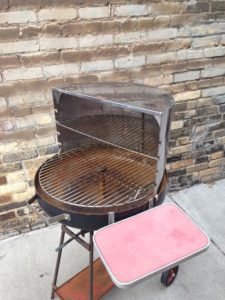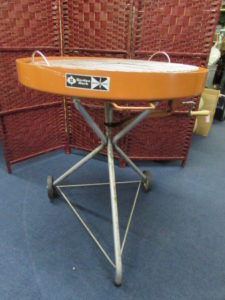
Man has long had rites of spring. Once upon a time, it was the pagan festival of Astarte (from which we derived the term Easter). The Druids would celebrate the equinox at Stonehenge. But in the 1960’s, it was the annual purchase of a cheap flat barbecue grill.
These grills could be obtained at places like Western Auto, Otasco (a local home/auto chain store based in Oklahoma), Sears, Montgomery Wards, and other pre-Wal Mart establishments. They ran about ten bucks or so in their most basic form.
They consisted of thin steel painted blue or red. The cheapest ones were simply flat cylinders about three feet in diameter and four to six inches in depth, with two brackets diametrically opposed allowing you to move the grill itself up and down over a range of six inches. They sat upon tubular legs which placed them about 36″ high.
However, if you were willing to spring for a few extra bucks, you could get yourself a deluxe model with a windscreen.
As tight with a buck as dad was, I remember we always had barbecue grills with the wind screen. As a matter of fact, circa 1971, we had one with a motorized spit, which would slowly turn a whole chicken or roast while you went inside and watched the baseball game.
The thin metal which comprised the grills meant that you bought a new one every year. That paint would soon begin flaking off, and the grill would begin to rust. By fall, it was looking pretty sad. When it got too cold to cook outdoors, it would simply sit in the weather and continue to deteriorate, until it would be disassembled and consigned to the trash.
It was possible to get a second year out of it if you kept it out of the weather. But the heat from cooking would still get to the paint and make them ugly.
Of course, along with the grill was kept the supply of charcoal briquets and starter fluid. The briquets needed to be kept dry, else they would swell up and become nonburnable. Starter fluid came in a tin vessel that was about eight inches tall, four inches wide, and two inches thick. It had a popup plastic spout, so you could turn it upside down and liberally douse the charcoal (piled into a heap in the middle of the grill) in the hope that you would have a beautiful bed of glowing embers upon which you could cook your burgers.

However, what was more likely to happen was that you would fail to let the fluid soak in thoroughly enough. A match would cause the pile to flame brightly, but it would soon go out, with the bare edges of the charcoal lightly glowing, giving you a vague hope that cooking would be taking place within the next thirty minutes.
That necessitated spraying more fluid on, which would quickly burn off, but creating slightly more glowing edges to the briquets. And you needed to let EVERY TRACE of that fluid burn off, else your food would have a distinctive petroleum distillate tang to it.
Time to go get a beer and let it set.
Finally, with the wind building up and blowing ashes and such all over the yard, your pile of briquets was ready to be spread out and the grate placed over it, so those burgers could begin their transformation into delightfully delicious treats to be eaten off of paper plates.
There were better grills like Weber Kettles back then, but most suburbanites and small-town dwellers simply purchased the inexpensive flat grills year after year.
Nowadays, I cook on a gas grill (with a spare bottle ready to spring into action) that has a vinyl cover to keep it dry from the elements. I take advantage of the heat that gathers in the upper confines of the enclosure to slowly bake thick steaks, making them delectably perfect, slightly pink in the middle. And my top secret marinade in the fridge makes them taste like heaven on earth.
But while I tend my grill, which is durable enough to last for years, I sometimes let my mind wander back to dad making some pretty darned good tasting meals on inexpensive sheet-metal contrivances that were purchased every spring.